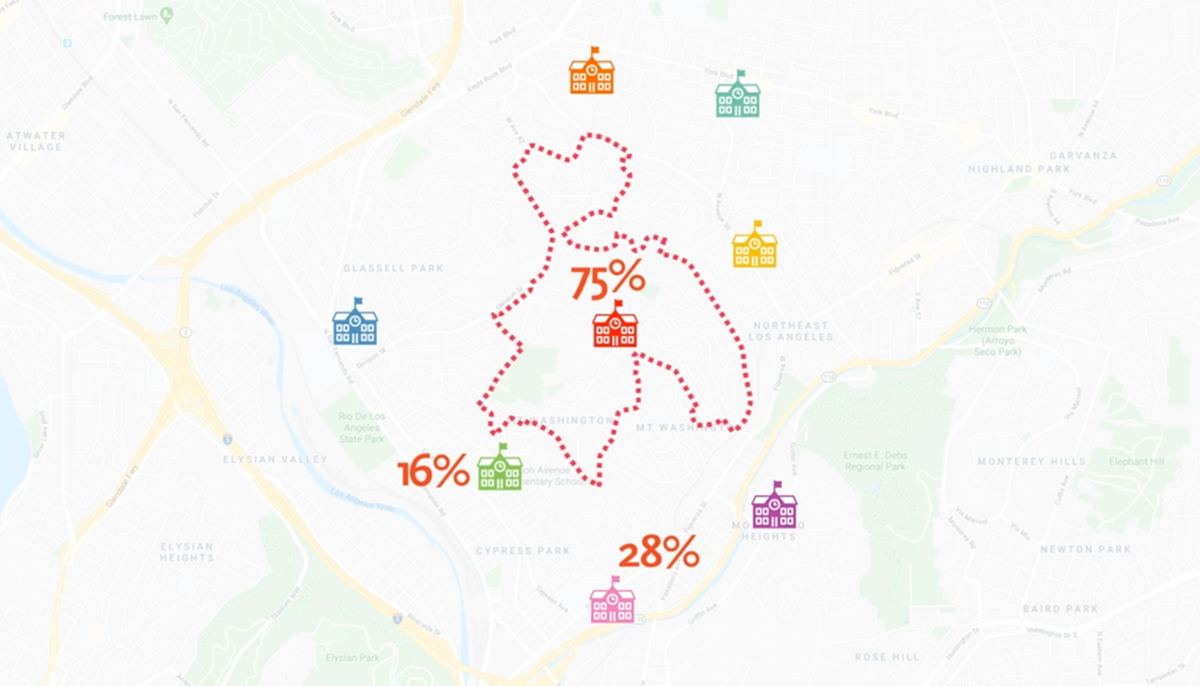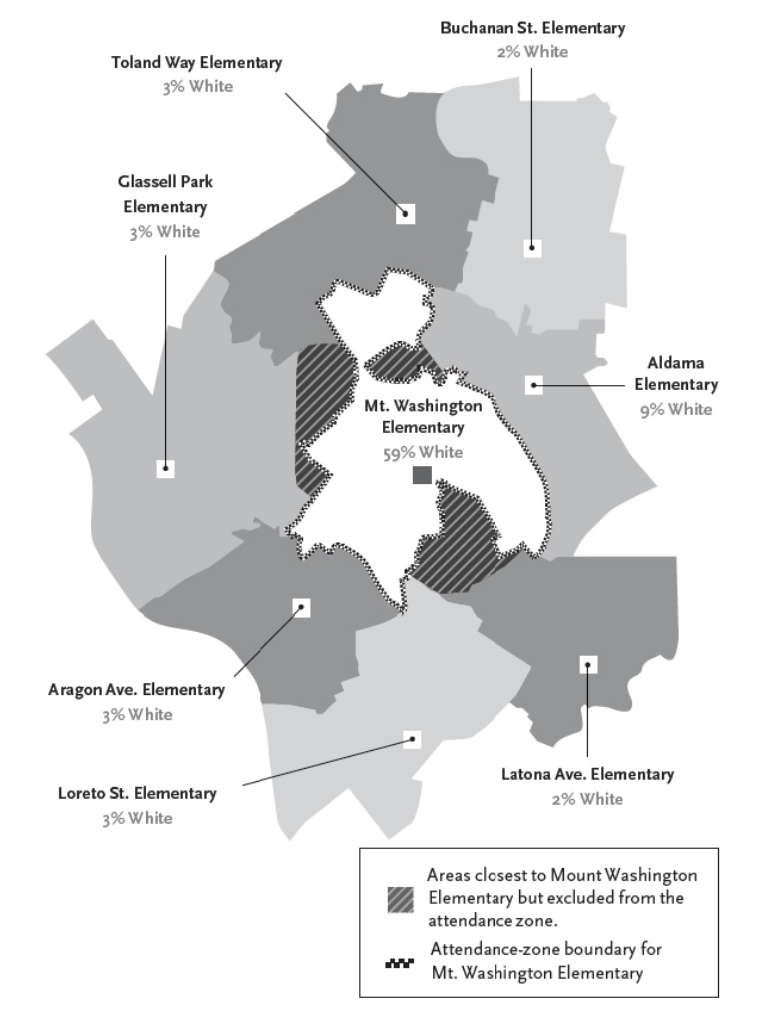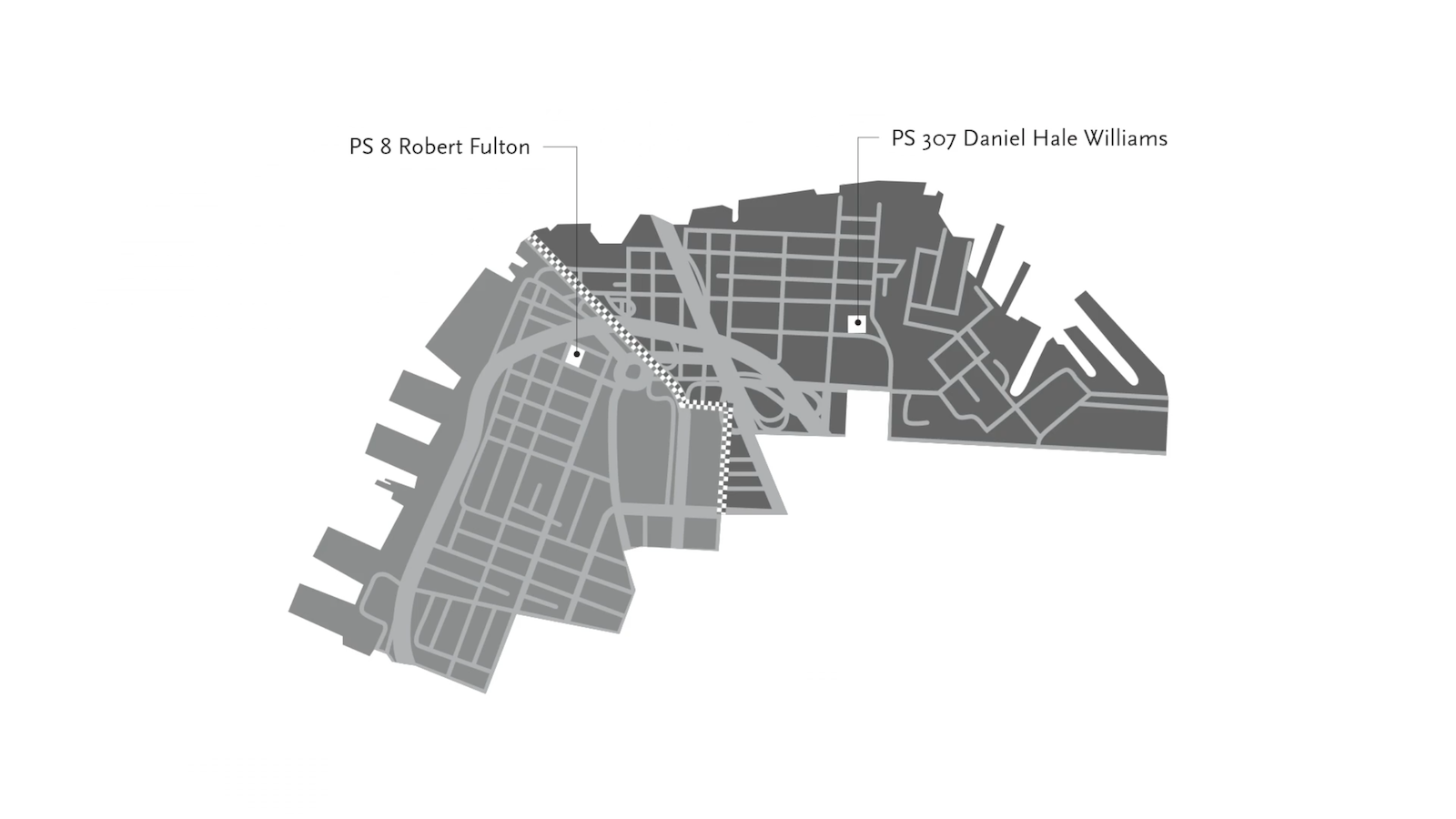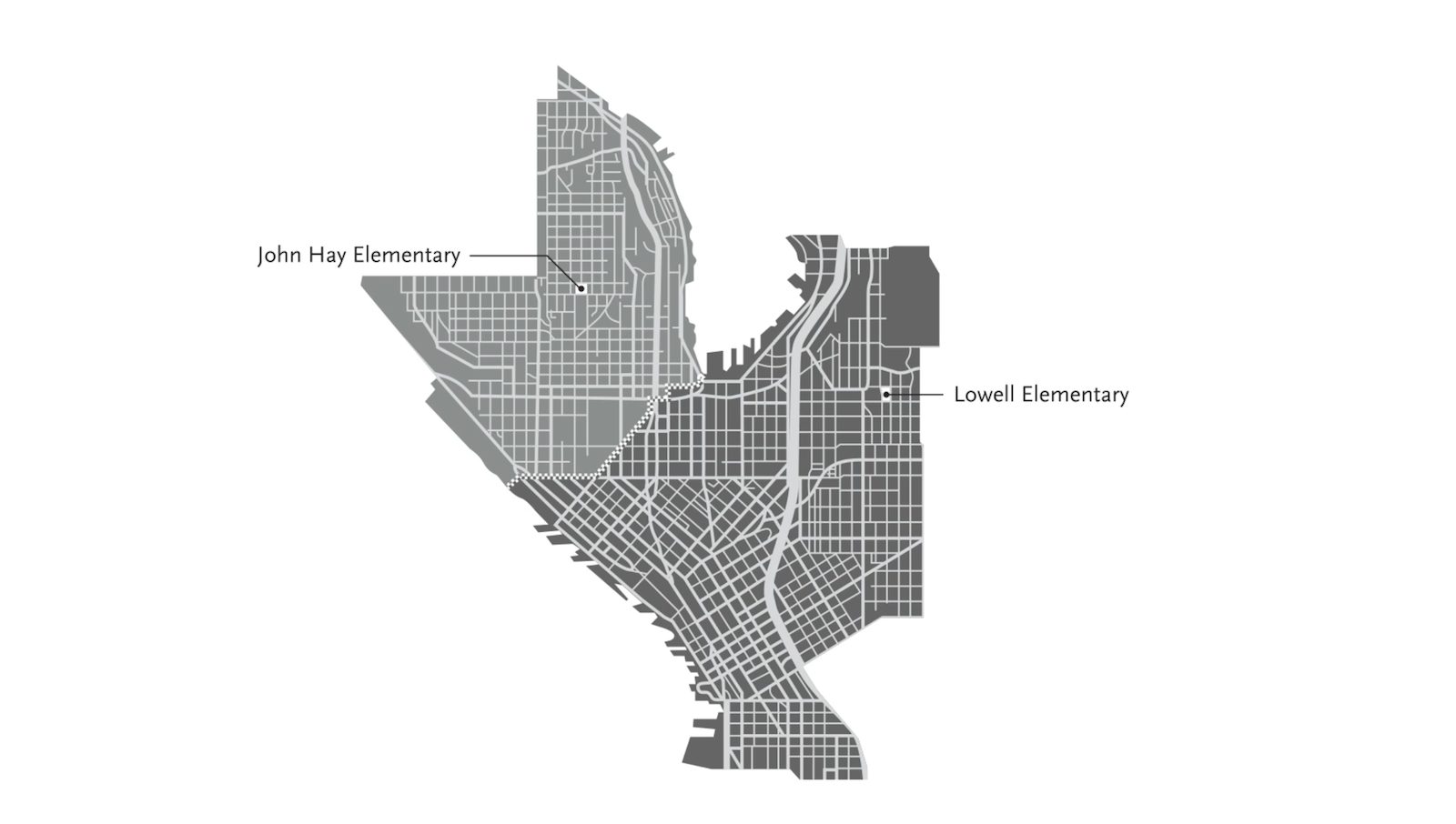
The Covid-19 pandemic has drawn renewed attention to inequality in K-12 education in the United States. Some schools and systems have quickly transitioned to high-quality distance learning, while others have struggled to provide students with effective learning experiences.
While the context is new, these inequalities predate the pandemic. Even after decades of increases in per-pupil spending and ongoing waves of reform, there are huge disparities in the quality of public schools, even those within the same district and just blocks away from one another. And access to the best public schools is often restricted based on where you live.
Take two schools, for example, that serve the Old Town neighborhood of Chicago. Lincoln Elementary is one of the crown jewels of the Chicago Public Schools, with 80% of the students proficient in reading. Just over a mile south is Manierre Elementary, where not a single graduating eighth grader tested proficient in reading in 2019.
What keeps the two schools separate? An attendance zone boundary. Children who live north of North Avenue enroll in elite Lincoln Elementary. Children south of North Avenue are not allowed to enroll in Lincoln and are assigned to failing Manierre. For a child in Old Town, your fate turns on whether you live on one side of the street or the other.
This is an American phenomenon. In nearly every city the pattern is the same: State law allows (or even requires) the district to draw attendance zones showing who gets to attend which schools. Districts use the lines to determine who can enroll in these elite, high-performing public schools. Young families respond to the policies by cramming into the coveted zone, driving up home prices. Other parents lie about their address to gain access. The divide between the two schools, often just blocks apart, grows over time.
The Supreme Court ended overt segregation of the public schools with its 1954 ruling in Brown v. Board of Education. Conventional wisdom says that school districts, in accordance with Brown, can assign children to schools in any way that they want, as long as they don’t discriminate based on race.
But conventional wisdom has forgotten about the Equal Educational Opportunities Act of 1974.
The School Nearest Your Residence
In March 1972, President Nixon was feeling boxed in by the issue of desegregation. Many federal courts had signed off on busing plans that would force the integration of public schools in districts that had previously engaged in overt segregation. But members of both parties—including Joe Biden—opposed federal-court-ordered busing.
Nixon opposed busing, but he also wanted to express sympathy for children caught in failing schools that were divided along racial lines. So, on March 17, he delivered an address to the American people, offering a compromise. He proposed a moratorium on federally mandated busing but also a “companion measure” called the Equal Educational Opportunities Act, which would increase funding for inner-city schools, especially those attended by minorities.
That law, the EEOA, wouldn’t be signed for another two years. Presidents Nixon and Ford would have to negotiate with lawmakers in order to get it through the Democratic Congress. The resulting law is a strange mix of high-minded goals and status-quo-ism. It’s all there in the first sentence of the law:
The Congress declares it to be the policy of the United States that—(1) all children enrolled in public schools are entitled to equal educational opportunity without regard to race, color, sex, or national origin; and (2) the neighborhood is the appropriate basis for determining public school assignments.
On the one hand, it promises equal opportunity.
On the other hand, it endorses neighborhood-based schools and district-drawn attendance zones. Given the existence of racially segregated neighborhoods, neighborhood-based schools would, by default, mean schools divided along racial lines. The EEOA also implicitly endorses the assignment of students to schools by the district or the state, rather than a more open system in which parents would play a more active role in determining which public school their child attends.
However, here is what Section 1703 of the EEOA has to say about the assignment of minority children to public schools:
No State shall deny equal educational opportunity to an individual on account of his or her race, color, sex, or national origin, by . . . the assignment by an educational agency of a student to a school, other than the one closest to his or her place of residence within the school district in which he or she resides, if the assignment results in a greater degree of segregation of students on the basis of race, color, sex, or national origin…
The full implications of that language have not yet been widely understood. For minority children, federal law defines the neighborhood school as “the one closest to his or her place of residence within the school district in which he or she resides.” And Congress prohibits the district from assigning a minority child to another school, if it will result in “a greater degree of segregation.”
What is this peculiar, misshapen thing that we call an attendance zone? It’s an administrative service area. Government bureaucrats carve up the map and determine who gets preferred enrollment at what school. There are no elected officials at the attendance-zone level—and no political representation. The residents of a school zone are not subject to special taxes that go to the local school. An attendance zone is also a license to discriminate. If the school is full (most of the best schools are), then the attendance zone provides the school with the ability to exclude families who live within the district’s jurisdictional boundaries but outside of the arbitrary zone for that school as drawn by district staff.
Note here that I’m not talking about the boundaries between school districts, which are political subdivisions. Those lines are jurisdictional. As governmental entities, school districts are typically overseen by elected or appointed board members. School districts often have the legal authority to assess taxes on their constituents or issue bonds in order to fund the district’s activities. That’s not true at the attendance zone level.
Most attendance zones are irregular in shape, which means that there are many pockets where families whose closest school is highly coveted (and high performing) are assigned to another school that may be struggling or even failing. The existence of these pockets appears to be in violation of the EEOA.
Figure 1 shows the attendance zone for Mount Washington Elementary in Los Angeles and the seven elementary schools that encircle it. At highly coveted Mount Washington, 75% of the students were proficient in reading in 2019, while the surrounding schools have reading proficiency rates between 16% and 54%. As a result, families pay a premium of $200,000 or more for a house that falls on the right side of the Mount Washington attendance zone boundary.

Figure 1. Mount Washington Elementary in Los Angeles violates a federal civil rights law that prohibits minority students from being assigned to a school that is not the nearest to their home if it exacerbates segregation.
Source: California Department of Education and Los Angeles Unified School District.
For families who live in the striped areas of the map, Mount Washington is their closest school. Because Mount Washington is so much “whiter” than the surrounding schools, L.A. Unified School District is creating a “greater degree of segregation” by assigning minority students living in those striped areas to other, more distant schools. Any minority student living in those areas—black, Hispanic, Asian, Native American—could file a claim in the federal courts, asking the courts to force Mount Washington Elementary to allow them an equal opportunity to enroll.
Similar maps could be created for any number of public schools in American cities. P.S. 8 in Brooklyn. John Hay Elementary in Seattle. Lakewood Elementary in Dallas. Mary Lin Elementary in Atlanta. Lincoln Elementary in Chicago. Ivanhoe Elementary in Los Angeles. Chesterton Elementary in San Diego. Penn Alexander Elementary in Philadelphia. Each of these schools is a coveted public school showing above-average student performance, and each is surrounded by underperforming schools with high concentrations of poor, minority students.
Other sections of the law provide more clarity about exactly what is permitted and what is illegal. Section 1704 explicitly states that districts do not have to maintain a balance “on the basis of race, color, sex, or national origin.” Racially imbalanced schools are not in violation of the law, as long as minority students have not been assigned to schools farther from their home.
Also, it’s perfectly legal under the EEOA for the district to assign a minority child to a school that is not the nearest to their residence, if it does not exacerbate segregation. Take a Hispanic child whose closest school is Aragon Avenue Elementary, which has only 3% white students and only 16% overall proficiency in reading. The district is free to assign that child to attend Mount Washington Elementary, because such an assignment would alleviate segregation, rather than exacerbate it. And minority students are free to choose a school that is not nearest to their homes, regardless of its impact on segregation, because the district has not assigned them there.
Section 1705 says that “assignment on neighborhood basis [is] not a denial of equal educational opportunity.” On the surface, this appears to provide legal cover for attendance zones. But Congress, perhaps anticipating that districts could play games with the meaning of the word neighborhood, reiterates once again a very specific definition of a neighborhood school: It is “the school nearest [the student’s] place of residence.”
There is surprisingly little case law relevant to the EEOA. The major cases all deal with other provisions of the law, such as its requirement that states and districts take “appropriate action” to overcome obstacles to education that arise from language barriers. I’ve been unable to find any case law that interprets and applies the clause of the EEOA that governs student assignment.

Available to All on Equal Terms?
The harder you look at attendance zones, the more they appear to violate fundamental principles. Isn’t public education supposed to be “the Great Equalizer” providing equal opportunity for all children, regardless of race or income level? Aren’t we all supposed to be treated equally under the law?
In the landmark ruling of Brown v. Board of Education, Chief Justice Warren wrote:
In these days, it is doubtful that any child may reasonably be expected to succeed in life if he is denied the opportunity of an education. Such an opportunity, where the state has undertaken to provide it, is a right which must be made available to all on equal terms.
Sixty-six years after the Brown ruling, public education is still not “available to all on equal terms.” In 1951, they used Linda Brown’s race to keep her out of Sumner Elementary School. In 2020, they use a meandering line drawn through the neighborhood to keep many local children out of Mount Washington Elementary.
After studying this issue for several years, I’ve come to the conclusion that attendance zones are—and should be—vulnerable to legal challenge. This vulnerability extends beyond an EEOA challenge to the shape of a particular zone.
Look first at the state constitutions. There are seven states in which the state constitution requires the legislature to establish schools that are “open to all”: Alaska, Arizona, Indiana, New Mexico, North Dakota, South Carolina, and South Dakota. This is the question for those state courts: If a school can decline to enroll a child solely based on his or her residential address within the district, is that school truly “open to all” the residents of the district? I don’t think that it is.
Similarly, five states promise “equality of educational opportunity.” Louisiana, Montana, and North Carolina mention this phrase (or something very similar) in their state constitution. The Supreme Courts of New Jersey and Tennessee have inferred that a similar constitutional right exists in those states. When a school-district official draws a geographic attendance-zone boundary assigning one child to a great school and denying enrollment to another child on the opposite side of the street, the district fails to provide the “equality of opportunity” that is promised by those five states.

But those aren’t the only states where attendance-zone boundaries may be vulnerable. In 13 states (including three that also have an “open to all” requirement), the courts have already declared education to be a “fundamental right.” In these states, the courts are required to apply “strict scrutiny” to any classifications that create unequal access to public schools. What’s important about strict scrutiny is that it transfers the burden of proof to the government, requiring them to show that the discrimination was necessary to further a “compelling governmental interest” and that the policy was “narrowly tailored” to achieve that interest.
Enrollment exclusions based on geography are hardly “narrowly tailored.” Indeed, in most states, charter schools are forbidden from establishing geographic attendance zones. Defenders of geographic zoning would be forced to argue that the government has a “compelling interest” in setting up exclusionary boundaries for some public schools, while forbidding them for others.
An even bigger question is whether attendance zones are vulnerable to challenge in the federal courts under the 14th Amendment’s promise of Equal Protection. Don’t these exclusionary zones violate Justice Warren’s commitment to the idea that a public education must be “available to all on equal terms”?
On the surface, it is an easy idea to dismiss. The federal courts only apply strict scrutiny to government actions when a “fundamental right” is restricted or a “suspect classification” is employed. But education is not a “fundamental right” under the U.S. Constitution, and classifications based on where you live do not create a suspect class as defined by the courts. Without strict scrutiny, such policies would face little risk of being overturned.
However, the Supreme Court’s original definition of Equal Protection, outlined in the early 1900s, appears to be at odds with the geographical enrollment preferences and attendance-zone boundaries that emerged in the mid-1900s and continue to be used today. In one of the first key cases that applied the concept of equal protection in a case that did not involve race (Royster Guano Company v. Virginia, 1920), the court said the following:
The classification must be reasonable, not arbitrary, and must rest upon some ground of difference having a fair and substantial relation to the object of the legislation, so that all persons similarly circumstanced shall be treated alike.
It seems clear that two children, living across the street from one another and within the jurisdictional boundaries of the same school district, are “similarly circumstanced” relative to the laws that establish the educational system. Are those two children “treated alike” when one is assigned to an elite public school and the other turned away because of where she lives?
No, they are not.
A case in the federal courts would focus on asking the judges to apply “intermediate scrutiny” to these discriminatory laws and policies, as they have done in other high-stakes cases involving equal access to public institutions of education. In Plyler v. Doe (1982), the Court overturned a Texas law that authorized school districts to deny enrollment to children who were undocumented immigrants. The Court applied the standard in Brown that education “must be made available to all on equal terms.” In US v. Virginia (1996), the Court struck down the male-only admissions policy at the Virginia Military Institute because the State had failed to provide a “substantially comparable” alternative to women who had been turned away. No court could fairly deem Manierre Elementary to be “substantially comparable” to Lincoln Elementary.
Some will argue that it is very unlikely that the courts will use the Equal Protection clause to strike down a policy that has such a long history in our country and that is so widespread. Could be. But we should all be troubled that attendance zones appear, at the very least, to violate the spirit of equal protection.
One Supreme Court justice, writing in 1992, saw the wisdom in focusing on equal access in the public schools. Justice Antonin Scalia argued that we should open up the public schools to all comers, imagining an educational system “in which parents are free to disregard neighborhood-school assignment, and to send their children (with transportation paid) to whichever school they choose.”
In a concurring opinion in the Freeman v. Pitts desegregation case, Justice Scalia argued that the Court could have taken a different approach in the years after the Brown decision. By overseeing complicated desegregation plans, the Court had waded deeper and deeper into the operations of school districts, prescribing all sorts of bureaucratic remedies that might in theory transform a “segregated” district into a “unitary” one.
Instead, Justice Scalia proposed that the court could have simply focused on school access:
An observer unfamiliar with the history surrounding this issue might suggest that we avoid the problem by requiring only that the school authorities establish a regime in which parents are free to disregard neighborhood-school assignment, and to send their children (with transportation paid) to whichever school they choose. So long as there is free choice, he would say, there is no reason to require that the schools be made identical. The constitutional right is equal racial access to schools, not access to racially equal schools.
To Scalia, equal access was a more justiciable question—a question more appropriate for the courts to weigh in on—than the question of what actions could be taken to transform a “segregated” district into a “unitary” one.
In the same opinion, Scalia predicted that the Court’s longstanding approach to desegregation was destined to make the courts irrelevant, as districts removed all remnants of overt (or de jure) segregation. And his prediction was right: Today almost all school districts are judged to be “unitary,” despite stark ongoing divisions of race and class, since they are far enough removed from any overt policies that segregated the schools by race.
Focusing on access, as Scalia suggested, would restore the courts’ rightful role as a guardian of equal opportunity in the schools. It would not mean that a child has a right to attend a specific school. Good public schools are scarce, especially in the inner cities. Great public schools are even harder to find. Not everyone will be able to attend the best school in the district. But all district residents should have an equal opportunity to enroll in the best schools in the district. In a public school lottery, for example, there are winners and losers. The results may seem frustrating or even tragic. But a lottery gives every district family a fair chance—an equal opportunity—to enroll their child at a coveted school that could dramatically change his or her life trajectory.

We may feel sympathy for people who might be harmed by rulings that would open these elite schools to all residents of a district. Take a family who has paid $250,000 more for a house because of its guaranteed access to an elite public school. Those parents wanted to secure the best education for their children, and that’s laudable. But that doesn’t mean we should continue to block open access to these public schools.
In some ways, these people are like the taxi companies in New York City. Taxi companies paid millions of dollars for “medallions” allowing them to operate taxis within the city. For years, these medallion owners fought off efforts to issue more medallions—and improve taxi service for millions of New Yorkers—because they wanted to be protected from competition. With the emergence of ride-sharing services such as Uber, the medallions lost much of their value. And taxi companies have attempted to use their political clout to block such services and retain their protected position.
But the courts have said no. Buying a taxi medallion does not mean that you are protected from disruptive competition until the end of time. Likewise, buying a house that gives you preferential access to a public school does not mean that you will be able to keep other families out forever.
If the courts look to open up the public schools, perhaps the most appropriate ruling would be a narrow one that simply forbade school districts from using a resident child’s address to determine their eligibility for any school within the district. Instead of being forced to implement a specific court-endorsed remedy, districts would be free to experiment with different allocation methods that don’t rely on geography.
Some districts would create a system of school-site lotteries, like most charter schools use. Others would implement a centralized lottery like the ones used in New Orleans, San Francisco, and Washington, D.C. You could even imagine districts trying a system based on “first-come-first-serve,” as Los Angeles did for many years with highly coveted dual-language immersion programs. Each of these approaches has shortcomings and the potential for abuse. But, unlike the current system, they are based on a principle of equal opportunity.
Local school officials should not, and do not, have unlimited power to determine who gets access to what schools. They are constrained by civil rights laws passed by Congress, and they are constrained by the founding documents of our democracy, both the state constitutions and the U.S. Constitution. Those constraints need to be enforced if we want to see a world in which a child’s home address does not play such a critical role in determining his or her destiny.
Tim DeRoche is author of A Fine Line: How Most American Kids Are Kept Out of the Best Public Schools. Twitter: @timderoche.


